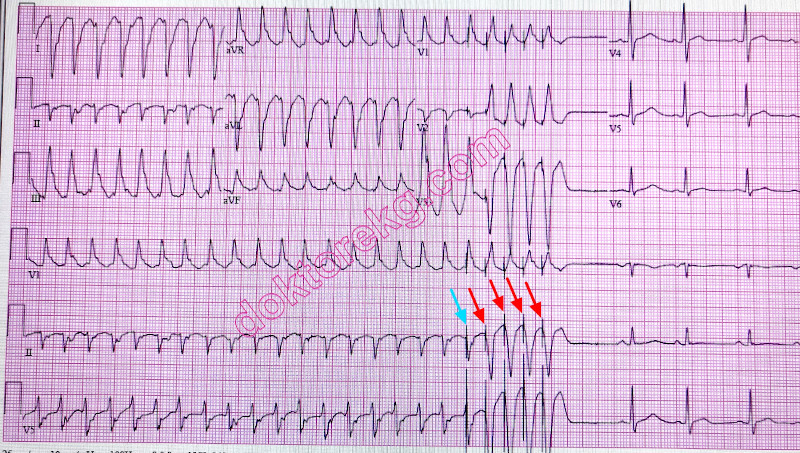doktorekg.com
AntiTachycardia Pacing (ATP)
 ATP is a safe, effective and painless therapy for termination of atrial or ventricular tachycardias (VT).
ATP is a safe, effective and painless therapy for termination of atrial or ventricular tachycardias (VT).
 Tachycardias with reentry mechanism are the most susceptible to pacing termination.
Tachycardias with reentry mechanism are the most susceptible to pacing termination.
 Automatic tachycardias are not terminated by pacing.
Automatic tachycardias are not terminated by pacing.
AntiTachycardia Pacing (ATP) for ventricular arrhythmias
 ATP consists of one or more trains of pacing stimuli (usually 8 impulses for each train) conventionally expressed as a percentage of the tachycardia cycle length for a given RR interval, from the onset of the preceding R wave.
ATP consists of one or more trains of pacing stimuli (usually 8 impulses for each train) conventionally expressed as a percentage of the tachycardia cycle length for a given RR interval, from the onset of the preceding R wave.
 The rationale for ATP efficacy relies of the fact that monomorphic VT can be interrupted with appropriately timed pacing stimuli delivered into the excitable gap of a reentrant circuit.
The rationale for ATP efficacy relies of the fact that monomorphic VT can be interrupted with appropriately timed pacing stimuli delivered into the excitable gap of a reentrant circuit.
 ATP therapy is effective in interrupting VTs, both slow and fast.
ATP therapy is effective in interrupting VTs, both slow and fast.
 VT with spontaneous RR interval variability are more likely be ATP responsive, while those with greater variation in QRS morphology (polymorphic VT) are less responsive.
VT with spontaneous RR interval variability are more likely be ATP responsive, while those with greater variation in QRS morphology (polymorphic VT) are less responsive.
 ATP reduces the number of unnecessary ICD shocks.
ATP reduces the number of unnecessary ICD shocks.
 ATP improves both patients quality of life and device longevity.
ATP improves both patients quality of life and device longevity.
References
 World J Cardiol 2017;9(5):429-436
World J Cardiol 2017;9(5):429-436
 Pacing Clin Electrophysiol 1997;20(8 Pt 2):2121-2124
Pacing Clin Electrophysiol 1997;20(8 Pt 2):2121-2124

ECG 1. The rhythm on the left side of the above ECG is ventricular tachycardia (VT).
The patient had undergone permanent cardiac pacemaker implantation in the past.
During the VT, the pacemaker intervenes with AntiTachycardia Pacing (ATP).
The first pacemaker impulse results in a Fusion beat.
The following 4 pacemaker stimuli converts VT to the sinus rhythm.
Dr Wayne Whitwam has donated the above ECG to our website.
Click here for a more detailed ECG
 ATP is a safe, effective and painless therapy for termination of atrial or ventricular tachycardias (VT).
ATP is a safe, effective and painless therapy for termination of atrial or ventricular tachycardias (VT).
 Tachycardias with reentry mechanism are the most susceptible to pacing termination.
Tachycardias with reentry mechanism are the most susceptible to pacing termination.
 Automatic tachycardias are not terminated by pacing.
Automatic tachycardias are not terminated by pacing.
AntiTachycardia Pacing (ATP) for ventricular arrhythmias
 ATP consists of one or more trains of pacing stimuli (usually 8 impulses for each train) conventionally expressed as a percentage of the tachycardia cycle length for a given RR interval, from the onset of the preceding R wave.
ATP consists of one or more trains of pacing stimuli (usually 8 impulses for each train) conventionally expressed as a percentage of the tachycardia cycle length for a given RR interval, from the onset of the preceding R wave.
 The rationale for ATP efficacy relies of the fact that monomorphic VT can be interrupted with appropriately timed pacing stimuli delivered into the excitable gap of a reentrant circuit.
The rationale for ATP efficacy relies of the fact that monomorphic VT can be interrupted with appropriately timed pacing stimuli delivered into the excitable gap of a reentrant circuit.
 ATP therapy is effective in interrupting VTs, both slow and fast.
ATP therapy is effective in interrupting VTs, both slow and fast.
 VT with spontaneous RR interval variability are more likely be ATP responsive, while those with greater variation in QRS morphology (polymorphic VT) are less responsive.
VT with spontaneous RR interval variability are more likely be ATP responsive, while those with greater variation in QRS morphology (polymorphic VT) are less responsive.
 ATP reduces the number of unnecessary ICD shocks.
ATP reduces the number of unnecessary ICD shocks.
 ATP improves both patients quality of life and device longevity.
ATP improves both patients quality of life and device longevity.
References
 World J Cardiol 2017;9(5):429-436
World J Cardiol 2017;9(5):429-436
 Pacing Clin Electrophysiol 1997;20(8 Pt 2):2121-2124
Pacing Clin Electrophysiol 1997;20(8 Pt 2):2121-2124

ECG 1. The rhythm on the left side of the above ECG is ventricular tachycardia (VT).
The patient had undergone permanent cardiac pacemaker implantation in the past.
During the VT, the pacemaker intervenes with AntiTachycardia Pacing (ATP).
The first pacemaker impulse results in a Fusion beat.
The following 4 pacemaker stimuli converts VT to the sinus rhythm.
Dr Wayne Whitwam has donated the above ECG to our website.
Click here for a more detailed ECG